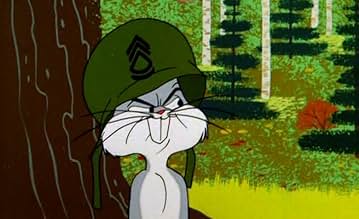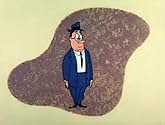Füge eine Handlung in deiner Sprache hinzuA psychological study of the behavioral effects of headgear as Bugs and Elmer continually switch personas depending on which hats they wear.A psychological study of the behavioral effects of headgear as Bugs and Elmer continually switch personas depending on which hats they wear.A psychological study of the behavioral effects of headgear as Bugs and Elmer continually switch personas depending on which hats they wear.
- Regie
- Drehbuch
- Hauptbesetzung
- Bugs Bunny
- (Synchronisation)
- …
- Elmer Fudd
- (Synchronisation)
- (Nicht genannt)
- Narrator
- (Synchronisation)
- (Nicht genannt)
Empfohlene Bewertungen
However, the real highlights here are the abstract backgrounds. One of the things I love about this era of Looney Tunes is how experimental the crew got in making unique-looking backdrops, a far cry from the realistic styles from the late '30s to early '50s. The setting is an early fall forest, but it's not drawn lushly as to imitate real life; its influence is more UPA and magazines of the time, where objects such as trees and rocks are more loosely defined but still recognizable to the human eye as to what they are. The color combinations are similarly fantastic, with the predominant color being green, but mixed with browns and blacks, plus splashes of reds and yellows to signify fall. Still frames from this cartoon could be used as actual paintings in a museum, they're that striking. At the same time, the backgrounds don't overtake the comedy- it's more something extra you appreciate after you've seen the cartoon a couple times.
This wasn't the only LT cartoon to experiment with background styles, but it was one of the most impressive results.
I do not know if anyone else noticed (if you watched the episode) but this episode reminded me of the sort of activities one does in drama, changing your personality completely just to sort an outfit. A bit like the reviewer Lee Eisenberg with his random theories, it may have only occurred to me and not to anyone else...
Anyway, here is a list of the good things about this Bugs Bunny + Elmer Fudd episode: 1. The idea is a clever and amusing one and is used well in the cartoon. 2. The "base" characters are good in this episode and the "added" characters are also very well done and amusing. 3. The cartoon opens and ends well, parts of episodes I feel can very often be patchy in a Looney Tunes cartoon. 4. The back-ground animation is very good, the character animation could be better, but it is not an issue in this episode. 5. The music was well done and often changed dramatically in this cartoon, which I liked.
If there was anything I did not like so much about the episode, it was the quickness of some of the character changes, the unnecessary pauses between some of the character changes and the slightly racist point where Bugs Bunny starts shooting Elmer Fudd as soon as Bugs is wearing Native American costume (I thought Americans had gone a bit better about that by the mid 1950's, but maybe I was mistaken).
I recommend this episode to any fan of Bugs Bunny and Elmer Fudd cartoons, to people who enjoy Looney Tunes in general and to people who love quick-changing personalities in a cartoon.
WUSSTEST DU SCHON:
- WissenswertesBugs recites the actual Boy Scout pledge, with a few added phrases.
- PatzerWhen he is transformed into the old lady, Elmer drops his gun. Yet, after Boy Scout Bugs helps him across the street, the gun is lying on the ground on that side.
- Zitate
Bugs Bunny: [wearing a judge's wig] You're a family man, Monahan, so I'm only going to sentence you to 45 years, at hard labor. One thing I cannot stand is a dishonorable police officer.
Elmer Fudd: [as a bride] Ohhhh, ju-u-u-udge? Will you marry me?
Bugs Bunny: [groom's hat flies on top of Bugs' head] Certainly, my darling sweety. I would be delighted to marry up with you.
Top-Auswahl
Details
- Laufzeit7 Minuten
- Sound-Mix
- Seitenverhältnis
- 1.37 : 1
Zu dieser Seite beitragen



















